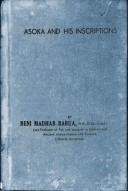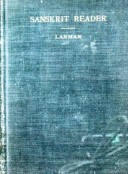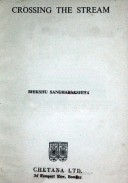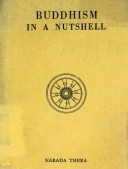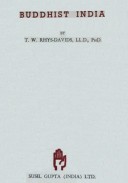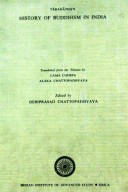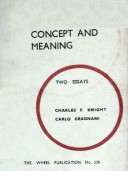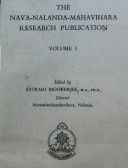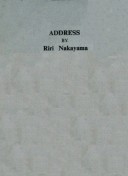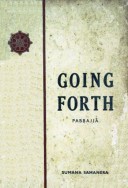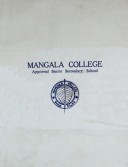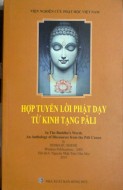Tìm Sách
Sách tiếng Anh-English >> Asoka and his Inscriptions
Thông tin tra cứu
- Tên sách : Asoka and his Inscriptions
- Tác giả : Beni Madhab Barua, M.A., D.Lit.
- Dịch giả :
- Ngôn ngữ : Anh
- Số trang : 368
- Nhà xuất bản : New Age Publishers Ltd. 22, Canning Street. Calcutta-I
- Năm xuất bản : 1955
- Phân loại : Sách tiếng Anh-English
- MCB : 12100000002555
- OPAC :
- Tóm tắt :
ASOKA AND HIS INSCRIPTIONS
BY BENI MADHAB BARUA, M.A., D.Lit. (Lond.)
Late Professor of Pali and Lecturer in Sanskrit and Ancient Indian History and Culture, Calcutta University.
1st Edition—1946 2nd Edition—1955
Published by:
J. N. Sinha Roy.
New Age Publishers Ltd. 22, Canning Street. Calcutta-I
Printed Part I by :
Sambhunath Mukhopadhyay at Sree Sakti Press,
5 & 6 Chowringhee Terrace,
Calcutta-20
Part II by :
R. K. Dutta at Nabasaktl Press,
123, Lower Circular Road. Calcutta-14
Rupees 15/-
PREFACE
The present work on Asoka and his Inscriptions is the outcome of a prolonged study of the inscriptions and legends of the great Maurya emperor in their manifold historical bearings. Since I was initiated into the study of Indian inscriptions at first-hand in 1912 by the late Professor R. D. Banerji, then a Superintendent of the Archaeological Section of the Indian Museum, Calcutta, my strong conviction was that with a mere knowledge of the palaeography indispensable to decipherment and of the dictionary meaning of the words employed was not in itself sufficient for either a correct interpretation of the epigraphs or a thorough grasp of their importance as historical documents. A first-hand knowledge of contemporary literature and its language was as much a desideratumas the historical training and intellectual equipment for a proper assessment of their evidentiary values. In other words, the mere epigraphist or the mere linguist was incompetent to fulfil this task. And since I became associated with the Post-Graduate teaching in Arts inaugurated by Sir Asutosh Mookerjee in the premier Indian University of Calcutta, I began to press the need of supplementing the teaching of the inscriptions by trained epigraphists with that imparted by capable teachers in the language and literature departments, the epigraphic evidence being inseparable from the collective literary evidence.
The original plan was just to edit the inscriptions including also those subsequently discovered or deciphered since the publication of Hultzsch's work. Failing to publish the edition thus prepared for some reason or other, I had to remain content with the publication of Part II of my first work containing translations and notes. Encouraged by the reception accorded to this publication, I set my heart upon the present work intending it at fiirst to serve as a short historical introduction to the first work. The present
extension of its scope was far beyond my original contemplation.
The widening of the historical vision has been partly due to a desire to justify the digression made from the path of the history of Indian Philosophy often regretted by Professor Sir Sarvapalli Radhakrishnan and other sincere friends and well-wishers, and partly due to a desire to vindicate, however imperfectly, the way of studying history from a philosophical and scientific point oi view, treating the history of a country primarily as a comprehensive view of its collective life-movement. Here the reader may find the results of an honest endeavour for the realisation of° some of the ideas formulated by me in the Presidential Address delivered in the Ancient Indian Section of the Indian History Congress held at Annamalainagar, South India, in December, 1945.
Thus it will be seen that my work on Asoka and his records has grown up by at least three stages with the result that some of the earlier interpretations have been either completely abandoned or appreciably amended at a later stage ; some of the questions which were left open in the previous publication have been finally decided in the present work. The reader’s attention may particularly be drawn to the discussion of the significance of Asoka’s epithets Devana- mpriya and Priyadasi laja Magadhe, the place of Pitinikas in relation to the Ristikas and Bhojas, and the precise import of Asoka’s statement sila vigadabhl cha kalapita. The relative values of the Asokan inscriptions and legends as materials for an authentic history have been carefully discussed. Nothing has been taken for granted. There is no foregone conclusion. The entire position of the history of Asoka has been critically reviewed in the light of the data derived mainly from a first-hand study of the inscriptions. The official functions of the Amta-mahamatas have been placed on a sure footing. Part I has been devoted to such relevant themes as Asoka’s personal history, empire, state, administration, personal and public life, dharma, dharmavijaya and place in history, while Part II, which is rather of a technical nature and, therefore, of little or no interest to general readers, has been devoted to the important problems that are apt to arise in connection with the study of the inscriptions from a purely linguistic and literary point of view. The appendix to Part I contains an instructive paper written by Dr. Iswarlal Topa of the Osmania University on Asoka's dhamma-culture.
It will be seen that the legends of Asoka have been free from bias or prejudice either within the four walls of a university or within the bounds of the four oceans, Aáoka who by his Dharmavijaya policy raised India in the estimation of the civilized world for all times to come is held responsible for the political or national decline of the Hindus, forgetting the fact that there was no idea of ‘nation' or ‘nationality' in India before Aáoka. If Asoka’s grandfather Chandragupta Was great, he was great not for being a tool at the hands of an Indian, Machiavelli but for his success,as observed by Justin, in making India free, “shaking off from its neck the yoke of slavery.'' If the Arthasasrta embodies the political maxims of a Kautilya, this is worked with all its shrewdness and sagacity to strengthen the position of an ambitious monarch aspiring only to be a mighty despot. If Kautilyas king believed that he was by his nationality just as much an Indian as his ministers and officers, viceroys and commissioners, there is no reason why he should have been advised not to trust any of them. The Magadhan method of administration, as noticed by Megasthenes, was a method, which evolved through a long line of rulers from the Brihadrathas down to the Nandas, and the much idolised Kautilya is nothing but a lineal descendant of Varshakara, the Brahman minister of Ajatasatru who proved to be a veteran in the nefarious art of sowing the seeds of disssension in the neighbouring Vrijian confederacy.
It is still uncertain whether Ạsoka's Pãrỉndas were the Pulindas of the Purănas. The name Parinda occurs in the Pali Chulavamsa (XXXVIII. 29-30) in which Parinda and Khuddaparinda are mentioned as two sons of a Pãndya King. It is possible, therefore, that the Parindas were racially connected with the Pandyas.
The facts are presented as far as these could be gathered from all available sources and ascertained, the findings are given for what they are worth, and the labours of previous scholars are fully utilised. Whether the views and interpretations offered by previous scholars are accepted or rejected, reasons have been given for that. Even if the findings be found untenable, the facts stand as they are, and this alone is my satisfaction that I have honesdy tried to facilitate a rational understanding of what is what.
My indebtedness to the whole body of Aáokan scholars headed by Prinsep and Cunningham and led further afield by Buhler and Senart is very great indeed. This does not mean, however, that the data of history should not be re-examined and revalued. If anyone has read or can interpret the Aiokan records and legends better, his or her suggestions and criticism are always welcome, but mere disparagement is certainly not the better part of valour. Fortunately, I am not altogether alone to take a different view of the history of Asoka.
When my right to deal with the ancient Indian inscriptions, particularly Asokan, was challenged by some of the epigraphist colleagues in the University, Mr. P. N. Banerjee m. a. Barrister- at-Law, then a Fellow and Syndic of the Calcutta University, rendered a most friendly service by asking me to vindicate my position, which in his opinion was unquestionable in this respect. I took up the challenge forthwith and published the paper entitled “Inscriptional Excursions’ in the Indian Historical Quarterly, Vol. II, No. 1, 1926, with the kind assistance of its editor, Dr. N. N. Law. I sincerely regret the polemical rune of my writing, although its worth was openly recognized by Professor D. R. Bhandakar in the revised edition of his Carmichael Lectures on Asoka. But the compliment which I then paid to Mr. Banerjee stating that he was “a friend of all earnest scholars” stands Justified all the more now when he has assumed his new responsible office of the Vice-Chancellor.
Bhandarkar’s original lectures on the subject were followed by Hultzsch’s masterly edition and translation of the Inscriptions of Asoka and Professor Radhakumud Mookerji’s monograph and Professor Raychaudhuri’s Political History of Ancient India. Among the bonafidePali scholars, Mr. Charan Das Chatterji, M. A., now Reader of Indian History at the University of Lucknow, and among my colleagues, Mr. Sailendra Nath Mitra, M. A., now Secretary to the Councils of Post-Graduate Teaching in Arts and Science, evinced a keen interest in the study of the Asokan inscriptions from the Buddhist literary point of view. I particularly wanted Mr. Mitra to prepare a critical edition of these inscriptions with as many close literary parallels as possible. He took up the work in right earnest only to give it up when he was about to reap a good harvest of his arduous labour. Thus I was compelled at last to do thework, with the assurance from Mr. Mitra that he would place at my disposal the new materials he was able to collect from various sources. These have been duly acknowledged wherever I have used them.
I am grateful to Dr. Syamaprasad Mookerjee, ‘President of the Council of post-graduate Teaching in Arts, Calcutta University, for his genuine interest in the progress of this work and no less to Dr. B. C. Law for his generosity. Among the senior and junior colleagues, I must gratefully mention the name of Professors S. K. Chatterji and Stella Kramerisch, Dr. N. R. Roy, the Bagiswari Professor of Fine Arts, and Messrs D. L. Barua, N. N. Dasgupta and Sultan Alam Choudhury for their helpful suggestions.
Mr. S. N. Mitra, Mr. Amitesh Banerjee, Professor of History, Daulatpur Hindu Academy, and my eldest son Mr. Basubandhu Barua, m. a. have helped me in deciding some of the disputed points. Mr. Anantalal Thakur m. a.,a University Research Scholar attached to me, has kindly prepared the indices, and my sixth daughter, Snehakana, has prepared the maps of Jambudvipa, Asoka's empire and five Greek territories.
A critical edition of the Pali counterparts of Buddha’s Discourses recommended by Asoka in his Bhabru Edict, which is prepared by Mm. Professor Vidhusekhara Bhattacharyya and which is being seen through the press, may be regarded as a useful supplement to this work.
The word tushtadanam, which is employed in the Arthasastra obviously as an équivalent of Asoka’s tuthâyatana, does not support Dr. Hetti Arachi’s equation of tuthâyatana with Pali titthàyatana.
Dated, Calcutta, The 20th May, 1946.
B. M. Barua
PART I
ASOKA
CONTENTS
CHAPTER I Pages
Introductory
1. Sources of information
2. Their relative values
CHAPTER II Pfrsonal History
1. Consecration
2. Conversion
3. Accession
4 Viceroyalty
5. Early life, parentage, brothers and sisters
6. Predecessors and pedigree (a) Social status
7. Wives and children
8. Successors
9. Length of reign and last days 10. Reign proper
CHAPTER III Empire
1. Extent of domain proper
2. Extent of empire
3. Sphere of influence
4. Pataliputra, the capital
CHAPTER IV State
1. Population
2. Territory
3. Sovereignty
4. Government
5. Constitution
6. Method and policy
7. Military strength and war policy
8. Sources of revenue
CHAPTER V
ADMINISRTATION
3. Imperial administration
4. Provincial administration
CHAPTER VI
Personal and Public Life
4. Asoka the man
2.Asoka the king
CHAPTER VII
Dharma
10. As rajadharma
11. As upasaka-dharma
12. As universal religion
CHAPTER VIII
Dharma-Vijaya
5. Definition of Dharma-vijaya
6. Dhrama-vijaya of great Epic
7. Trailokya-vijaya ofthe Karandavyuha
4 Digvijaya of Agni
5. Dharma-vijaya of Asoka
CHAPTER IX
Place in History
9. Services to Buddhism
10. Role as nation-builder
11. Political reaction of Dharma-vijaya -
APPENDIX
Asoka and his Dhamma Culture
By Dr. Ishwarlal Topa
 Facebook
Facebook
 Google
Google
 Google+
Google+
